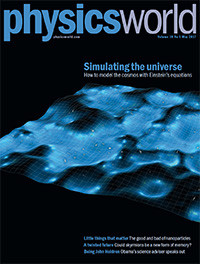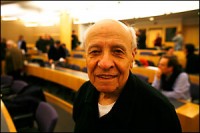Tag archives: spintronics
The May 2017 issue of Physics World is now out
 By Matin Durrani
By Matin Durrani
Einstein’s equations of general relativity might fit on a physicist’s coffee mug, but solving them is no mean feat. Now, however, the equations have been solved in a cosmological setting for the first time, as Tom Giblin, James Mertens and Glenn Starkman explain in the May 2017 issue of Physics World magazine, which is now live in the Physics World app for mobile and desktop
Elsewhere in the issue, you can enjoy an interview with John Holdren, who spent eight years as Barack Obama’s presidential science adviser. Find out too about the good and bad of nanoparticles and explore the potential that skyrmions – magnetic quasiparticles – could hold as a new form of memory storage.
Don’t miss either this month’s Lateral Thoughts, in which physicist Roger Todd describes how his invention of a system for automatically watering his house plants almost led to a commercial device.
Remember that if you are a member of the Institute of Physics, you can read Physics World magazine every month via our digital apps for iOS, Android and Web browsers.
View all posts by this author | View this author's profile
Cosmic rays, diamond anvils and spintronics in Utah

A blooming marvellous afternoon at the University of Utah.
By Hamish Johnston in Salt Lake City
Yesterday afternoon I hopped on a tram bound for the University of Utah. As you can see in the above photo, spring has sprung in Salt Lake City and the campus was resplendent in blossoms with views over snow-capped mountains.
I was at the university to film several 100 Second Science videos with Utah physicists including Shanti Deemyad, who studies the properties of matter under extremely high pressures. She is particularly interested in understanding the quantum properties of solids at temperatures near absolute zero – properties that can be enhanced when materials such as lithium are squeezed at pressures that are more than 10 million times greater than Earth’s atmosphere. This is done using a diamond anvil and Deemyad’s lab has 20 or so of them.
View all posts by this author | View this author's profile
Sounding off about valleytronics

Valley state: real-life landscapes can be as beautiful as their condensed-matter counterparts. (CC BY-SA BorisFromStockdale)
By Hamish Johnston
Condensed matter is a physicist’s paradise because of the seemingly endless number of ways that atoms can be rearranged to create systems with new and exciting behaviours. A great example of this is the emerging field of “valleytronics”, which is concerned with a property of electrons that emerges in some semiconductors and 2D materials such as graphene.
The eponymous valley is a local minimum in the conduction band of a solid that “traps” electrons into a specific momentum state. Things get interesting when a material has two valleys that result in two distinct momentum states. In some materials these states resemble the quantum-mechanical property of spin: an electron can be in one of two spin states (up or down) and it can also be in one of two momentum states. As a result, this property is sometimes referred to as valley pseudospin.
View all posts by this author | View this author's profile
Breathing new life into the Rashba effect
By Tushna Commissariat
Spintronics is often touted to be a field of research that one day soon will revolutionize computing as we know it, helping build the next generation of superfast and energy-efficient computers that we long for. Future spintronic devices will tap into the inherent spin magnetic moment of the electron, rather than just its charge, to store and process information. As an electron’s spin can be flipped much quicker than its charge can be moved, these devices should, in theory, operate faster and at lower temperatures than their current electronic-only counterparts.

Father of spintronics: Rashba at his 80th birthday celebration at Harvard University in 2008. (Courtesy: Matt Craig/Harvard News Office)
The entire basis of this field is built on research done by Soviet-American theoretical physicist Emmanuel Rashba in 1959. Indeed, he was the first to discover the splitting of the spin-up and spin-down states in energy and momentum with an applied electric field instead of a magnetic field. But Rashba’s original article detailing the effect, written together with Valentin Sheka, was published in a supplement of the Soviet-era, Russian-language journal, Fizika Tverdogo Tela, and is nearly impossible to get a hold of today.
New Journal of Physics (which is published by IOP Publishing, which also publishes Physics World) has now produced a focus collection of articles on the Rashba effect. As a part of this collection, guest editors Oliver Rader of the Helmholtz Centre Berlin, Gustav Bihlmayer of the Jülich Research Centre in Germany and Roland Winkler of the Northern Illinois University in the US worked with Rashba to create an English-language version of his original paper.
You can access the entire “Focus on the Rashba Effect” collection here, and the translated original paper here. In some ways, this highlights the importance of other key research articles that may have been published in journals that are no longer available and so may be in danger of being lost forever. Leave us a comment if you can think of any such papers.
View all posts by this author | View this author's profile